Drobo 5D with BeyondRAID - Protected Direct-Attached Storage Made Simple
by Ganesh T S on April 25, 2016 8:00 AM EST- Posted in
- Storage
- USB 3.0
- DAS
- Drobo
- BeyondRAID
Direct-Attached Storage Performance
Evaluation of DAS units on Windows is done with the testbed outlined in the table below. We had started evaluation with the older Haswell-based testbed, since it has Thunderbolt 2 support. Eventually, we learnt during the course of evaluation that the Drobo 5D's Thunderbolt ports are useless when the unit is used with PCs / Windows. Despite this, we continued and completed our evaluation using the USB 3.0 interface on the same testbed. We utilize the USB 3.0 port directly from the Z97 PCH.
| AnandTech DAS Testbed Configuration | |
| Motherboard | Asus Z97-PRO Wi-Fi ac ATX |
| CPU | Intel Core i7-4790 |
| Memory | Corsair Vengeance Pro CMY32GX3M4A2133C11 32 GB (4x 8GB) DDR3-2133 @ 11-11-11-27 |
| OS Drive | Seagate 600 Pro 400 GB |
| SATA Devices | Asus BW-16D1HT 16x Blu-ray Write (w/ M-Disc Support) |
| Add-on Card | Asus Thunderbolt EX II |
| Chassis | Corsair Air 540 |
| PSU | Corsair AX760i 760 W |
| OS | Windows 10 Pro x64 |
| Thanks to Asus and Corsair for the build components | |
The full details of the reasoning behind choosing the above build components can be found here. The list of Drobo 5D configurations used for comparison purposes is provided below.
- Drobo 5D SDR Yes mSATA (Single disk redundancy with mSATA acceleration)
- Drobo 5D SDR No mSATA (Single disk redundancy without mSATA acceleration)
- Drobo 5D DDR Yes mSATA (Dual disk redundancy with mSATA acceleration)
- Drobo 5D DDR No mSATA (Dual disk redundancy without mSATA acceleration)
Synthetic Benchmarks - ATTO and Crystal DiskMark
The Drobo 5D delivers best-case numbers of close to 300 MBps writes and 250 MBps reads in the single-disk / mSATA inactive configuration for our standard ATTO benchmarking configuration. Obviously, the benefits of mSATA acceleration don't come out in this quick-and-dirty benchmark. However, we can see that dual-disk redundancy solutions fare a little worse compared to the single-disk redundancy solutions.In any case, these access traces are not very common in real-life scenarios.
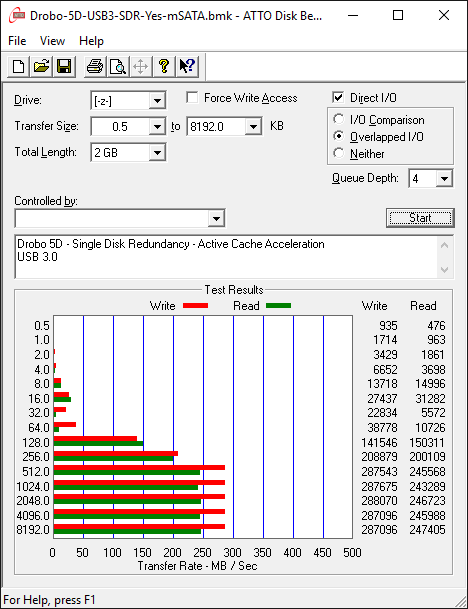
CrystalDiskMark, despite being a canned benchmark, provides a better estimate of the performance range with a selected set of numbers. In this case, we can see the sequential access numbers back up the ATTO results. Random access numbers are quite decent for a hard-drive array.
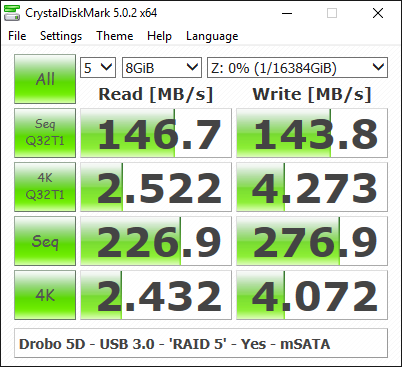
Benchmarks - robocopy and PCMark 8 Storage Bench
Our testing methodology for DAS units also takes into consideration the usual use-case for such devices. The most common usage scenario is transfer of large amounts of photos and videos to and from the unit. Devices like the Drobo 5D are often used to import files directly off the DAS into a multimedia editing program such as Adobe Photoshop.
In order to tackle the first use-case, we created three test folders with the following characteristics:
- Photos: 15.6 GB collection of 4320 photos (RAW as well as JPEGs) in 61 sub-folders
- Videos: 16.1 GB collection of 244 videos (MP4 as well as MOVs) in 6 sub-folders
- BR: 10.7 GB Blu-ray folder structure of the IDT Benchmark Blu-ray (the same that we use in our robocopy tests for NAS systems)






In all the above benchmarks, we see that the mSATA cache acceleration is not useful at all (we are testing out a one-time copy of data to and from the unit). The single-disk redundancy configuration consistently performs better than the dual-disk redundancy option.
For the second use-case, we take advantage of PC Mark 8's storage bench. The storage workload involves games as well as multimedia editing applications. The command line version allows us to cherry-pick storage traces to run on a target drive. We chose the following traces.
- Adobe Photoshop (Light)
- Adobe Photoshop (Heavy)
- Adobe After Effects
- Adobe Illustrator
Usually, PC Mark 8 reports time to complete the trace, but the detailed log report has the read and write bandwidth figures which we present in our performance graphs. Note that the bandwidth number reported in the results don't involve idle time compression. Results might appear low, but that is part of the workload characteristic.


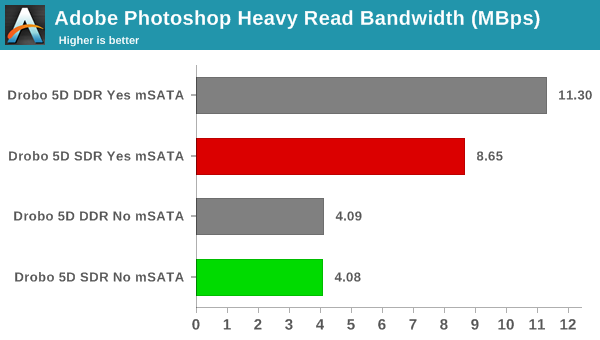

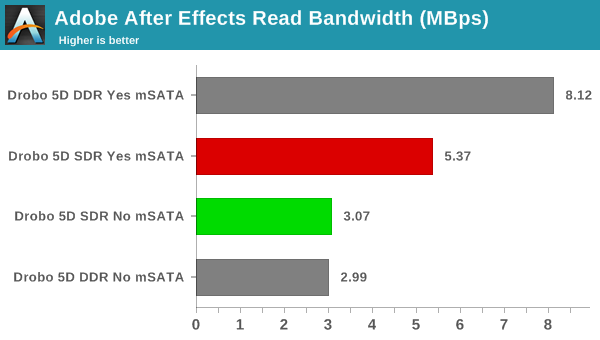

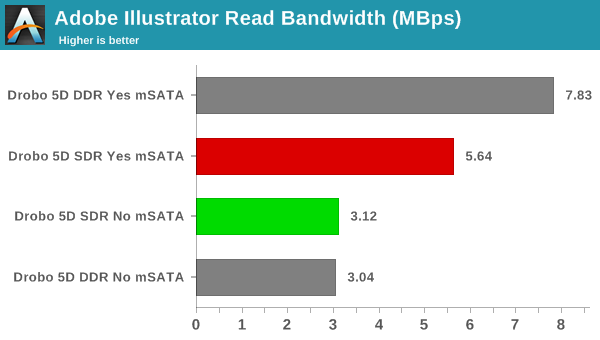

In the real-world work traces, we can see the real benefit of the mSATA SSD cache acceleration. Writes don't benefit much, but, in the read workloads, we can see that the mSATA SSD-enabled configurations often provide almost double the performance of a raw hard-drive array.










74 Comments
View All Comments
SirGCal - Monday, April 25, 2016 - link
Seagates: http://www.seagate.com/support/downloads/item/thun...Assuming I googled the right ones obviously. Simply put, while much rarrer for windows, they have been around. And for quite a while. I think the Intel driver is from 2014 or something for W7-8.1
tuxRoller - Monday, April 25, 2016 - link
Ganesh, is there a possibility that you could look at snapraid? I'm curious to see how it performs relative to the other solutions (like unraid, for instance), especially when it comes to bit rot and disk loss.I know that their are tools that are designed for the fs devs that will stimulate various behaviors (bad cables, bad controller, etc) which would make this test easier to perform.
One more fs you might be interested in is bcachefs (written, mostly, by former googler Kent Overstreet). To my knowledge, it's the only fs written outside of the filesystem layer in Linux (it works below the fs layer in the block layer). Its got a number of fascinating features and its design is extremely unusual.
https://bcache.evilpiepirate.org/
Navvie - Tuesday, April 26, 2016 - link
Don't hold your breath. Won't even cover ZFS despite lots of comments on the NAS reviews saying the ZFS is a better solution.Can't upset those hardware vendors or they might not send review samples.
ganeshts - Tuesday, April 26, 2016 - link
ZFS is simply not ready for *consumer-level* use unlike traditional RAID.Call me when the flexibility, performance and low-power nature of traditional RAID (both mdadm and hardware vendors) is matched by a ZFS system.
Pretty sure btrfs has better chance to replace traditional ext4 RAID in consumers from COTS vendors rather than ZFS for *consumer* use. Enterprise is a different story.
It is a matter of how much time you can invest in a review and return on that investment. The vendors play no role here.
I bet you didn't see this review of a DIY NAS: http://www.anandtech.com/show/9508/asrock-rack-c27...
Thanks for your thoughtful comment.
tuxRoller - Tuesday, April 26, 2016 - link
Performing further tests with that hardware would be great.I'd love to see how various setups perform (that is, it'd be nice if you imaged Linux, *BSD, and windows to test how their solutions compare.... including robustness, as I mentioned). It would be a big undertaking but I've not seen anything like that before and it seems like AT's audience would be interested.
rrinker - Monday, April 25, 2016 - link
The outside access stuff has been turned off by Microsoft dropping Windows Live several years ago.None of the other options that are current offer everything WHS does, the backup being key. I have an unlimited Crashplan account so I COULD back up each machine individually, but that means a lot more bandwidth utilization from the way it is now, which is the WHS backing them all up and deduping the data BEFORE it goes to Crashplan. And the recoveru is not nearly as convenient - with WHS you can mount any selected backup as a drive and just copy files off it. All backups are incremental and it automatically links them together so you just pick which date you want to recover from and you see the state of the whole drive as of that date, even if on that actual backup, it only backed up a tiny fraction of your files. My machine is more than capable of running Server 2012 R2, but no version does what I need (and WHS was cheap - definitely worth paying for). I could theoretically run WHS in a Hyper-V VM under 2012, but that makes doing the drive pool much more complex. Maybe VMware with passthru storage with all my storage drives.
HideOut - Monday, April 25, 2016 - link
So it says daisy chaining only works under macs? WTF? Do they not support the massive windows user platform fully?tarasis - Thursday, April 28, 2016 - link
I've had 2 Drobo units (both 4 Bay, 2nd and 3rd Gen), and generally speaking I've had a good run with them. The 2nd Gen was horribly slow, but then I wasn't putting stuff onto it that needed fast access. I was backing up (with an external single disk as an extra paranoid backup) data and videos, and streaming those videos off it. When the fan died and the cost of getting an out of warranty repair was nearly as much as buying a new 4 Bay drobo, I opted to get the 3rd Gen which is much faster be it over Usb 2 (that my server has) or USB 3 which my Hackintosh has.I like the Drobo because it is easy to mix and match drives and slowly increase the size over time as disk prices come down. IIRC (this was prob late 2007 or 2008) it was the easiest option for setting up an expandable backup/storage. I am a computer techie (and programmer by profession) but was also a stay at home dad of a 2 and 1 year old at the time who didn't have the time to look into building my own backup solutions with RAID or windows server or anything like that. I just wanted something that was fire and (mostly) forget.
Their SW is pretty poor and I miss the old version which updated the menubar icon with the actual disk state rather than a static icon. HW wise I've only had two problems, the first was on the new 2nd Gen, the power supply was borderline sufficient and under strain would cause the Drobo to reboot. They sent a new power supply out quickly and it was sorted in a couple of days. The second was that the fan was dying and very loud on the 2nd gen, but it had been going for 6 years well. I may yet try and replace it, I had found a blog where someone else had done it, but its not particularly a user replaceable part.
alanc - Friday, April 29, 2016 - link
Don't believe a word Drobo say. Their devices are just USB-bridges. They are dumping a load of flawed devices. Their support is the worst i have encountered in 35-years working in the field of IT. Their software is written by a blind-baboon, their quality-assurance staff were either bribed or drinking Tequila all day long. Their senior staff are insolent, argumentative and down-right jerks in many cases. Don't give these idiots your money.You have been warned..
zaphoddd - Wednesday, May 4, 2016 - link
I've a couple Drobos and would like to chime in.1. Have not had to use support (they have just worked for the last 4-5 years).
2. I can replace a bad drive without reconfiguring, managing, the box. Pull drive. Replace and it rebuilds. IIRC not necessarily the case with the others. Many require backing up, and rebuilding the volume.
2. I can pull drives from one drobo, and put them in another and my volume just shows up and works. IIRC thats not an option on most raid boxes
3. I can change the size of the volume on the fly. I can add bigger drives, and the volume knows what to do.
Things may have changed but the last time I looked at raid boxes - to change the setup, meant wiping the array, which means moving (and having a spare place to move) a dozen or so terabytes of files, and then moving them back. That's a no.
I connect one via USB, and one via FW800 - neither is a speed demon, but not noticeably slow by any means. File transfers speeds are comparable with standard drives. Newer models have a SSD cache.
I'm just a dude, with lots of data, and its been safe for years on my 2. I've had 1 drive failure, and after replacing the drive, it rebuilt just like I expected it to. Just replaced the drive and let it be. Lights turned green, volume was rebuilt.
I'm surprised by the strongly worded protests. Interesting.